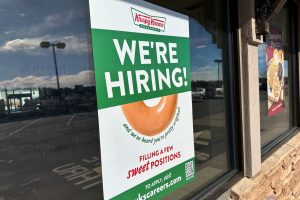
Inflation ticks higher, upping shopping season pressure
WASHINGTON — Consumer price increases accelerated last month, the latest sign that inflation’s steady decline over the past two years has stalled in recent months.
According to the Federal Reserve’s preferred inflation gauge, consumer prices rose 2.3% in October from a year earlier, the Commerce Department said Wednesday. That is up from just 2.1% in September, though it is still only modestly above the Fed’s 2% target.
Yet excluding the volatile food and energy categories, so-called “core” prices also picked up, climbing 2.8% last month from a year earlier, up from 2.7% in September. Economists closely watch core prices because they typically provide a better read on where inflation is headed.
Inflation has fallen sharply since it peaked at 7% in mid-2022, according to the Fed’s preferred measure. Yet yearly core inflation has fluctuated between 2.6% and 2.8% since February. Price increases have remained elevated in services, including apartment rents, restaurant meals, and car and home insurance.
Wednesday’s report also underscored that Americans’ incomes and spending remained healthy, a key reason the economy has kept growing this year despite widespread fears of a slowdown. Incomes grew 0.6% from September to October, faster than economists had expected, while consumer spending rose by a solid 0.4% last month.
But the public still feels inflation’s sting: Prices are about 20% higher than they were in February 2021, just before inflation started picking up
Solid growth and stubborn inflation, however, may keep Federal Reserve officials from cutting their key interest rate as quickly as they had signaled at their last meeting in September. Many economists now expect they will reduce their rate by a quarter-point in December, then delay further cuts while gauging the impact of the reductions they made this year.
President-elect Donald Trump’s victory could also slow Fed rate cuts. His proposals to cut taxes and reduce government regulation could spur faster growth, but could also overheat the economy and lift inflation. And his threats to impose widespread tariffs, if carried out, would likely push up prices.
The Fed had signaled it would cut rates four times next year, but financial markets now expect just two reductions.
In a separate report, federal economists said the American economy expanded at a healthy 2.8% annual pace from July through September on strong consumer spending and a surge in exports.
Consumer spending, which accounts for about 70% of U.S. economic activity, accelerated to a 3.5% annual pace last quarter, up from 2.8% in the April-June period and the fastest growth since the fourth quarter of 2023. Exports also contributed to the third quarter’s growth, increasing at a 7.5% rate, most in two years. Still, the third-quarter growth in both consumer spending and exports was lower than the Commerce Department initially estimated.
But growth in business investment slowed sharply on a drop in investment in housing and in nonresidential buildings such as offices and warehouses. By contrast, spending on equipment surged.
When he takes office next month, President-elect Trump will inherit an economy that looks broadly healthy.
Still, Trump has promised an economic shakeup. On Monday, he vowed to slap new import taxes on goods from China, Mexico and Canada. Mainstream economists view such taxes — or tariffs — as inflationary. That is because they are paid by U.S. importers, who then seek to pass along the higher costs to their customers.
Wednesday’s report was the second of three looks at third-quarter GDP. The Commerce Department will issue the final report on Dec. 19.
As seen from a drone, Jason Kwapi operates a combine, at left, during soybean harvesting on the Voss farm near Palo, Iowa earlier this year. (Nick Rohlman/The Gazette via AP, File)

